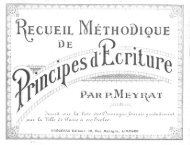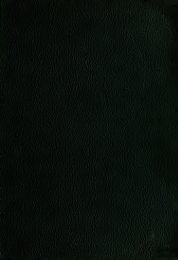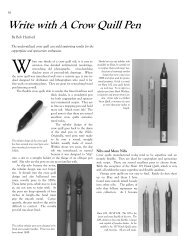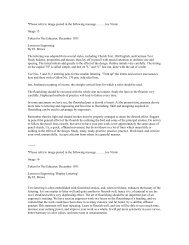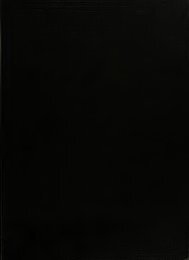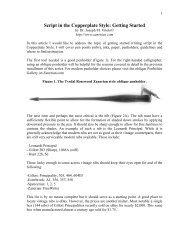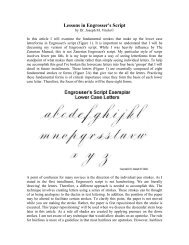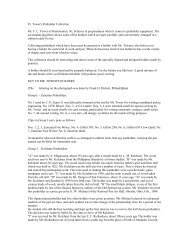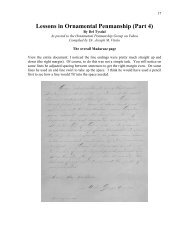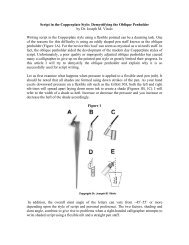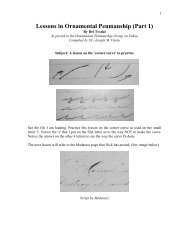The Educator (Volume 45) - IAMPETH
The Educator (Volume 45) - IAMPETH
The Educator (Volume 45) - IAMPETH
You also want an ePaper? Increase the reach of your titles
YUMPU automatically turns print PDFs into web optimized ePapers that Google loves.
16<br />
Directions for Blackboard Practice<br />
B. C. E. Doner, State Teachers Colleges Bridgewater, Framingham, Salem, Massachusetts, Handwriting Department<br />
To write well upon the blackboard<br />
is not only an individual accomplishment<br />
for a teacher, but it is a duty<br />
a teacher owes to her pupils. It is<br />
therefore, important that a teacher<br />
be a good blackboard writer. Good<br />
writing is the result of clear thinking,<br />
purposeful pi-actice, and a strong determination<br />
to improve.<br />
This shows a good position at the board.<br />
—<br />
Stand well back from the board<br />
nearly at arms length—and do all<br />
erasing with the left hand. Never<br />
use a whole pietfe of chalk. If the<br />
chalk is sharpened a little bit it will<br />
give a clear, smooth line. Do the<br />
erasing both horizontally and vertically<br />
by using a rather slow firm<br />
motion. To erase with a quick<br />
thoughtless motion stirs up needless<br />
chalk dust. Avoid this. When writing<br />
use both shoulder and elbow motion,<br />
drawing all downward strokes<br />
at an angle of about twenty degrees<br />
to the right of the vertical for the<br />
correct slant. <strong>The</strong> hand should not<br />
touch the board. Aim at all times<br />
for a strong, firm white line that will<br />
carry well to the back of the room<br />
for easy reading by the pupils. Hard,<br />
dustless chalk is best for general<br />
practice. A firm uniform slant gives<br />
Lnd your pupils to the blackboard fnqnmtU in thlaterial<br />
can profitably be practiced first at the board<br />
definite amount of space and see that he stands erect<br />
character to the writing. Avoid a<br />
broad, thick line. Hold the chalk<br />
firmly, use a little pressure, and push<br />
the chalk along fluently with a regu-<br />
lated control of pauses and accelerations.<br />
Study the copy and fit the<br />
motion to the complexity or simplic-<br />
ity of the letter or word, but remember<br />
the fluent swing is the thing.<br />
First write with sureness and accu-<br />
racy, then develop speed. In lifting<br />
the chalk from word to word, re-<br />
volve it quickly in the fingers so as<br />
to write on the point or sharp edge<br />
for firm clear lines. When not actu-<br />
ally writing, release the grasp of<br />
holding the chalk to relax the fingers<br />
of the hand and arm. Keep the elbow<br />
well back from the board.<br />
To write horizontally straight, look<br />
a little to the left, then to the right,<br />
then pass the hand from left to right,<br />
so that when you do write the lines<br />
will be straight. Also, start with<br />
the \veight of the body on the left<br />
foot, gracefully shifting the weight<br />
to the right foot as you write. Keep<br />
directly in front of your writing.<br />
However, in illustrating before the<br />
class adjust your position so that the<br />
n i.in>hip .lass. New and difficult<br />
id then un paper. Give each pupil<br />
id swings the arm and body freely.<br />
pupils will see the act of writing. To<br />
write straight, step to the right at<br />
intervals. Write about in front of<br />
the eyes in general practice, varying<br />
this a few inches above and below the<br />
level.<br />
Lift-handtd students should be encouraged to<br />
write on the board because blackboard writing<br />
is easier than pen and ink work. <strong>The</strong>y<br />
should stand at arms length and look directly<br />
at the work.



